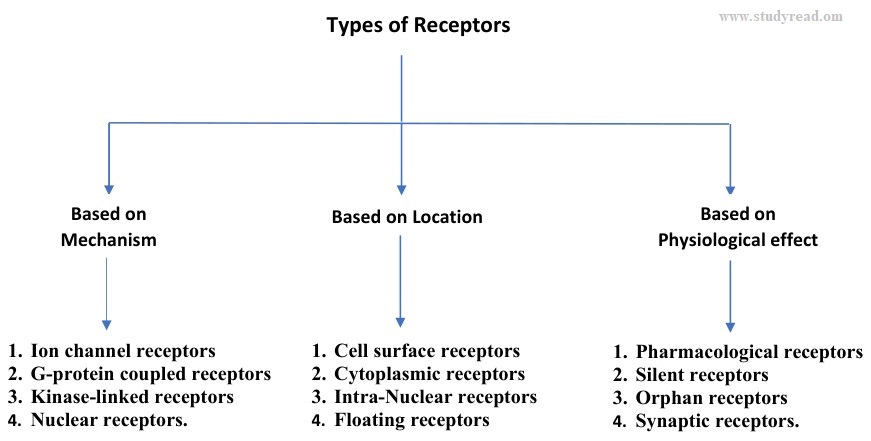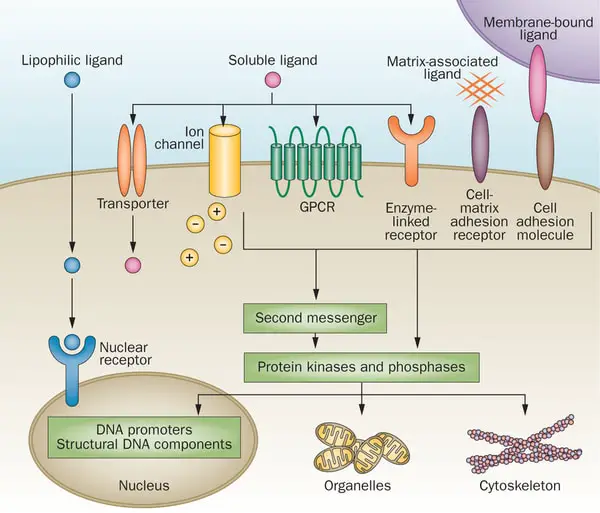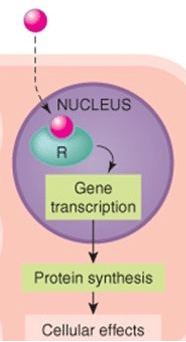Receptors are the sensing elements that communicate a signal from the ligand to the cell to elicit a specific physiological response.
A ligand is a molecule that can bind to the receptor and produce a specific response.
This ligand can be a drug or an endogenous molecule like neurotransmitters, opioid peptides, hormones, etc.

There are four basic types of receptors, like
- Ligand-gated ion channel receptors
- G-protein coupled receptors
- Kinase-linked receptors
- Nuclear receptors.
These receptors are located in the cells and tissues and help control almost all the body organs.
The ligand is the one that binds to the receptor and brings in conformational changes to produce a definite effect on the body’s physiology.
Most receptors generally have endogenous ligands or biomolecules, which can trigger a response.
Most receptors are named based on their endogenous ligands like serotonin, acetylcholine, and opioids.
As per IUPHAR, there are hundreds of receptors in the body. They vary regarding the changes they bring about in the body when a ligand binds.
Types of Receptors in detail
Based on their molecular structure and mechanism:
- Ligand-gated ion channel receptors
- G-protein coupled receptors
- Kinase-linked receptors
- Nuclear receptors.

Ligand-gated ion channel receptors
They are also called ionotropic receptors. These receptors are the ones that have a channel through which ions can move inside and outside the cells.
They are located on the cell membrane and have a ligand-binding site towards the external surface.
The ligand could be biomolecules like acetylcholine, GABA, or corresponding drugs.
The nicotinic acetylcholine receptor is one of the prominent receptors that fall into this category.
It is made of 4 different subunits named α, β, γ and δ.
These receptors elicit the fastest response in microseconds/ milliseconds. They are found in the nervous system.
Ions like Sodium, chloride, calcium, and potassium move into the cell or outside through them.
These receptors coordinate body responses like reflex action, sense of pain, touch, and movements.
Examples: Nicotinic acetylcholine receptors, GABAA receptors
G-protein coupled receptors
This is the largest class of receptors. They are also called metabotropic receptors.
These receptors are also membrane-bound but have their effector system in the cytoplasm.
These receptors are of 3 types as
- Rhodopsin family
- Secretin/glucagon family
- Calcium sensor family
These receptors act through both ligand-gated channels and also enzyme-linked pathways.

The response through these receptors takes a few seconds.
Adenylyl cyclase (cAMP) Pathway
Here, when the drug or ligand binds to the receptors, the enzyme adenylyl cyclase activates on the inner side of the plasma membrane.
ATP is metabolized to cAMP (cyclic AMP), which phosphorylates protein kinase (an enzyme).
This phosphorylated protein kinase activates many reactions by phosphorylation of proteins and enzymes.
Example: Glucagon activates the enzyme glycogen phosphorylase that converts glucose to glycogen in the liver and skeletal muscles.
Similarly, Muscarnic M2 receptors also work through this mechanism.
Other receptors with this mechanism include Adrenergic β-receptors, follicle-stimulating hormone, adrenocorticotrophic hormone, Somatostatin, thyroid-stimulating hormone, etc.
Phospholipase C/IP3-DAG pathway:
The Phospholipase C/IP3-DAG (Inositol triphosphate-diacylglycerol) pathway is a vital signal transduction pathway initiated by G-protein coupled receptors (GPCRs).
This pathway is essential for numerous cellular functions, including cell growth, differentiation, and hormone action. Here’s a breakdown of the process:
- Activation of the G-Protein Coupled Receptor (GPCR)
The process starts when an extracellular ligand, such as a hormone, neurotransmitter, or growth factor, binds to a GPCR on the cell membrane. This interaction activates the associated G-protein, specifically the Gq protein.
- Gq Protein Activation
Once activated, the Gq protein undergoes a conformational change, leading to the exchange of GDP (Guanosine diphosphate) for GTP (guanosine triphosphate) on its alpha subunit.
The activated alpha subunit of Gq then separates from the beta and gamma subunits. It interacts with Phospholipase C (PLC), an enzyme on the cell membrane’s inner side.
- Phospholipase C (PLC) Activation
Activated PLC targets phosphatidylinositol 4,5-bisphosphate (PIP2), a phospholipid in the inner leaflet of the cell membrane.
PLC hydrolyzes PIP2 into two significant second messengers: inositol 1,4,5-triphosphate (IP3) and diacylglycerol (DAG).
- Role of IP3
IP3 is soluble and diffuses into the cytoplasm, binding to IP3 receptors on the endoplasmic reticulum (ER) membrane.
This binding triggers the release of calcium ions (Ca²⁺) from the ER into the cytosol, resulting in elevated intracellular calcium levels.
- Calcium as a Second Messenger
The increase in intracellular calcium ions activates various calcium-dependent processes, including muscle contraction, neurotransmitter or hormone secretion, and activating other signaling proteins like calmodulin and protein kinase C (PKC).
- Role of DAG
DAG, the other product of PIP2 hydrolysis, remains in the plasma membrane due to its lipophilic properties. DAG activates protein kinase C (PKC), which subsequently phosphorylates various target proteins, leading to alterations in cellular activities such as gene expression.
Kinase-linked or enzymatic receptors.
These receptors are also cytoplasmic but have an extra-cellular part that binds to a drug or ligand.
Their action involves enzymatic activation by phosphorylation.
Then, gene transcription and protein synthesis can produce the effect.

The response time is a few hours.
There are four different types of kinase-linked receptors, like
- Cytokine receptors.
- Receptors tyrosine kinases
- Serine/threonine kinases
- Guanylyl cyclase-linked receptors
Nuclear receptors
As the name indicates, these receptors are located in the nucleus of cells. They get activated when ligand molecules enter the nuclear membrane and bind with them.

Their response time is from hours to a few days.
These nuclear receptors are of two main types, like
- Class I: Ex: Estrogen and other steroid receptors.
- Class II: Ex: peroxisome proliferator-activated receptor
Based on their location in the body
As per their location and distribution in the body, they can be classified as
- Cell surface receptors (Ion-channel and G-protein coupled receptors)
- Cytoplasmic receptors (Enzyme-linked receptors like JAK-STAT)
- Intra-nuclear receptors (The hormonal receptors located in the nucleus)
- Floating receptors
Based on the physiological effect on the body
- Pharmacological receptors (These receptors elicit response for drugs)
- Silent receptors
- Orphan receptors
- Synaptic receptors.
Silent receptors
Silent receptors are those receptors to which ligands bind with high affinity, but interestingly, no pharmacological effect is produced.
Ex: Plasma proteins.
Orphan receptors
These are the receptors that do not have well-defined endogenous ligands.
But they can produce a response when other ligands bind to them. In other words, their actual endogenous ligands have not been discovered yet.
Once the endogenous ligand is identified, it will be given a specific name.
Synaptic receptors
These receptors show their effects at synapses after being stimulated by neurotransmitters.

Thank you, this is an excellent simplified review.
excellent concise review.